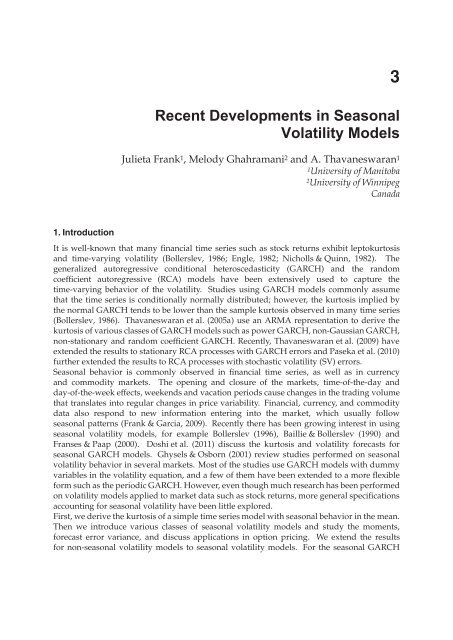The Limits of Mathematics and NP Estimation in ... - Chichilnisky
The Limits of Mathematics and NP Estimation in ... - Chichilnisky
The Limits of Mathematics and NP Estimation in ... - Chichilnisky
- No tags were found...
You also want an ePaper? Increase the reach of your titles
YUMPU automatically turns print PDFs into web optimized ePapers that Google loves.
Recent Developments <strong>in</strong> SeasonalVolatility ModelsJulieta Frank 1 , Melody Ghahramani 2 <strong>and</strong> A. Thavaneswaran 11 University <strong>of</strong> Manitoba2 University <strong>of</strong> W<strong>in</strong>nipegCanada31. IntroductionIt is well-known that many f<strong>in</strong>ancial time series such as stock returns exhibit leptokurtosis<strong>and</strong> time-vary<strong>in</strong>g volatility (Bollerslev, 1986; Engle, 1982; Nicholls & Qu<strong>in</strong>n, 1982). <strong>The</strong>generalized autoregressive conditional heteroscedasticity (GARCH) <strong>and</strong> the r<strong>and</strong>omcoefficient autoregressive (RCA) models have been extensively used to capture thetime-vary<strong>in</strong>g behavior <strong>of</strong> the volatility. Studies us<strong>in</strong>g GARCH models commonly assumethat the time series is conditionally normally distributed; however, the kurtosis implied bythe normal GARCH tends to be lower than the sample kurtosis observed <strong>in</strong> many time series(Bollerslev, 1986). Thavaneswaran et al. (2005a) use an ARMA representation to derive thekurtosis <strong>of</strong> various classes <strong>of</strong> GARCH models such as power GARCH, non-Gaussian GARCH,non-stationary <strong>and</strong> r<strong>and</strong>om coefficient GARCH. Recently, Thavaneswaran et al. (2009) haveextended the results to stationary RCA processes with GARCH errors <strong>and</strong> Paseka et al. (2010)further extended the results to RCA processes with stochastic volatility (SV) errors.Seasonal behavior is commonly observed <strong>in</strong> f<strong>in</strong>ancial time series, as well as <strong>in</strong> currency<strong>and</strong> commodity markets. <strong>The</strong> open<strong>in</strong>g <strong>and</strong> closure <strong>of</strong> the markets, time-<strong>of</strong>-the-day <strong>and</strong>day-<strong>of</strong>-the-week effects, weekends <strong>and</strong> vacation periods cause changes <strong>in</strong> the trad<strong>in</strong>g volumethat translates <strong>in</strong>to regular changes <strong>in</strong> price variability. F<strong>in</strong>ancial, currency, <strong>and</strong> commoditydata also respond to new <strong>in</strong>formation enter<strong>in</strong>g <strong>in</strong>to the market, which usually followseasonal patterns (Frank & Garcia, 2009). Recently there has been grow<strong>in</strong>g <strong>in</strong>terest <strong>in</strong> us<strong>in</strong>gseasonal volatility models, for example Bollerslev (1996), Baillie & Bollerslev (1990) <strong>and</strong>Franses & Paap (2000). Doshi et al. (2011) discuss the kurtosis <strong>and</strong> volatility forecasts forseasonal GARCH models. Ghysels & Osborn (2001) review studies performed on seasonalvolatility behavior <strong>in</strong> several markets. Most <strong>of</strong> the studies use GARCH models with dummyvariables <strong>in</strong> the volatility equation, <strong>and</strong> a few <strong>of</strong> them have been extended to a more flexibleform such as the periodic GARCH. However, even though much research has been performedon volatility models applied to market data such as stock returns, more general specificationsaccount<strong>in</strong>g for seasonal volatility have been little explored.First, we derive the kurtosis <strong>of</strong> a simple time series model with seasonal behavior <strong>in</strong> the mean.<strong>The</strong>n we <strong>in</strong>troduce various classes <strong>of</strong> seasonal volatility models <strong>and</strong> study the moments,forecast error variance, <strong>and</strong> discuss applications <strong>in</strong> option pric<strong>in</strong>g. We extend the resultsfor non-seasonal volatility models to seasonal volatility models. For the seasonal GARCH








